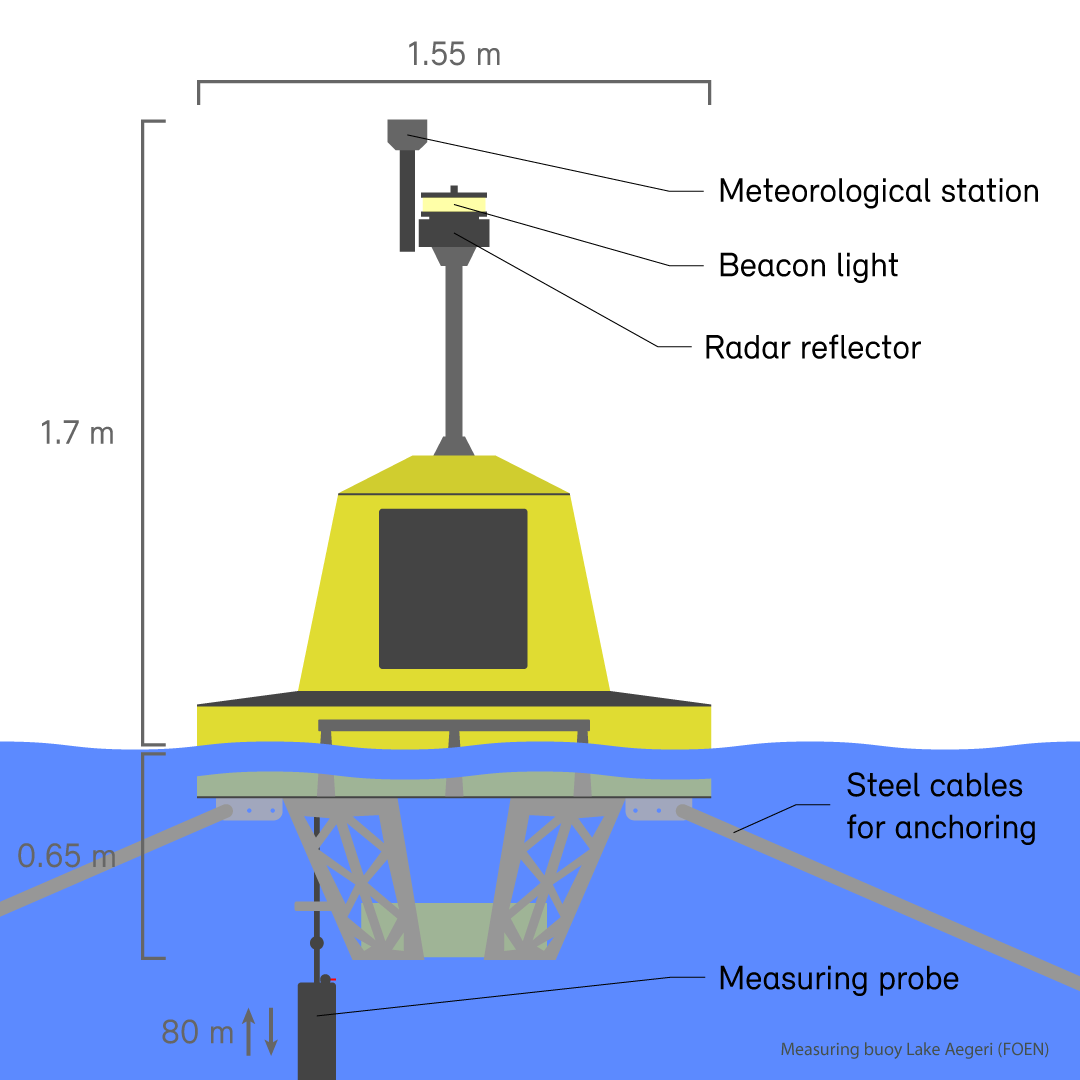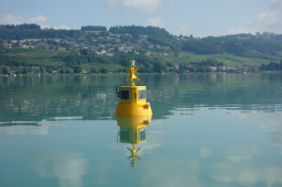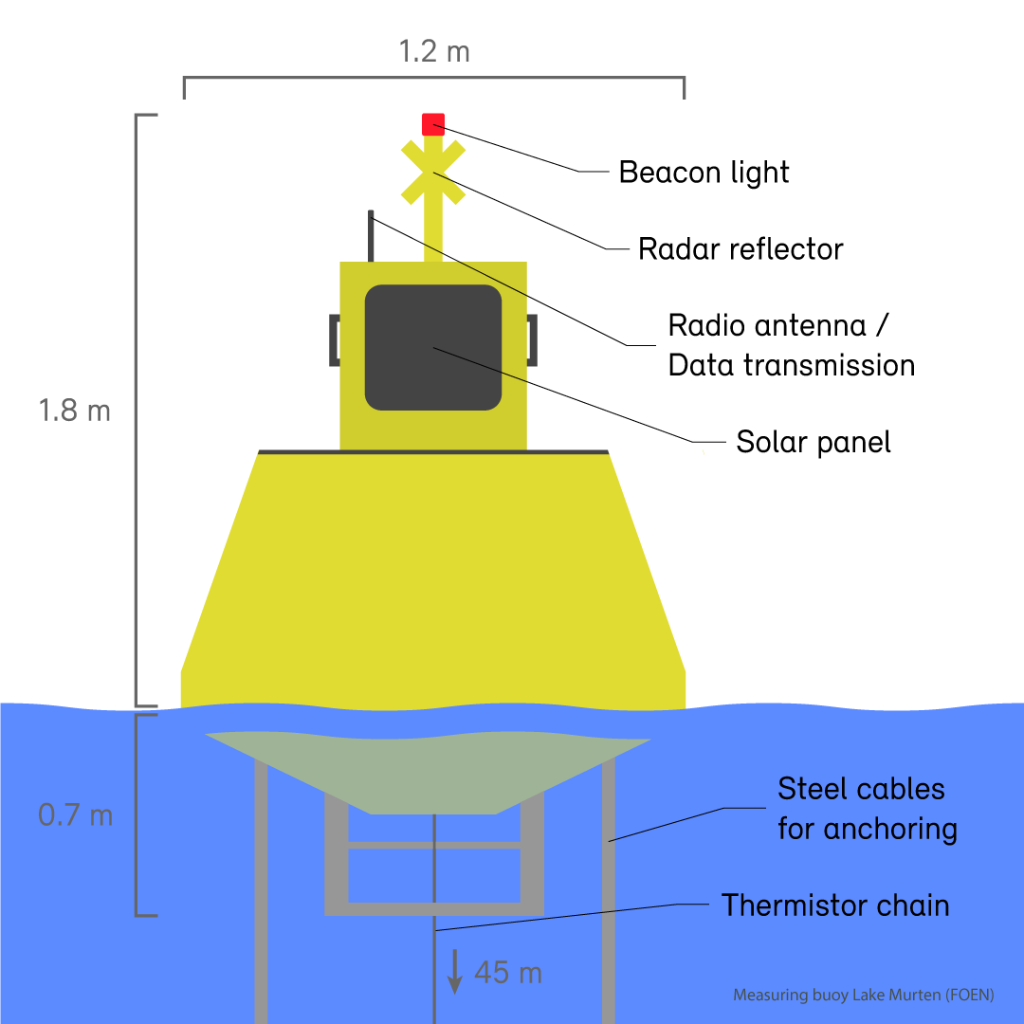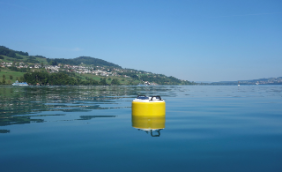14.11.2022 - The hydrologists of the Federal Office for the Environment (FOEN) have been measuring river temperatures for decades. This summer, the FOEN launched a pilot project in collaboration with Eawag to record the water temperature of individual lakes using automatic data buoys. This data is freely available to everyone. As part of this project, FOEN experts will also assess the feasibility of extending temperature monitoring to other lakes. Knowing about changes in lake temperatures is crucial to better understanding the lake ecosystem. It also makes it possible to monitor the effects of climate change and respond appropriately.

© FOEN
As part of this FOEN-financed pilot project, Eawag (the water research institute of the ETH Domain) began working with cantonal agencies in the summer and autumn of 2022 to operate new temperature measuring stations in the following three lakes: Lake Murten (FR/VD), Lake Hallwil (AG/LU) and Lake Aegeri (ZG). In Lake Murten and Lake Hallwil, the temperature is continuously measured at various depths with a thermistor chain, while in Lake Aegeri, a temperature probe sinks from the surface to the bottom of the lake to record temperature profiles several times a day. The data is publicly available in near real time and accessible online to everyone.
Similar temperature measuring stations are already in operation in eight other small lakes in different regions of Switzerland, but without real-time transmission. The aim is to monitor the effects that climate change is having on these lakes, which are important for drinking water supply, fisheries, recreation and biodiversity, among other things.
- Why do lake temperatures need to be monitored?
- Why were Lake Murten, Lake Hallwil and Lake Aegeri chosen for the pilot stations?
- How does monitoring work?
- Are the buoys in the lake dangerous for boats or swimmers?
- Will monitoring buoys be installed in all lakes in Switzerland?
- Where can I see the data and monitoring results?
- How can I retrieve the data?
- When can the first results be expected?
Why do lake temperatures need to be monitored?
The FOEN seeks to monitor Swiss lake temperatures to determine the effects of global warming. Until now, the Confederation has monitored water temperatures in numerous rivers in Switzerland, but not in lakes. It is now looking at whether the monitoring network can also be extended to lakes. This is in addition to the temperature monitoring that some cantons already carry out.
Temperatures are now monitored continuously at different water depths, i.e. from once a day up to several times a day, and from the surface to the deepest part of the lake, which is new. This makes it possible to track changes in water temperature – which also determine the stratification of the lakes – in real time and over longer time periods of time.
Continuous monitoring allows for a better understanding of the lake ecosystem than, for example, monitoring on a monthly basis. Chemical or biological processes, such as algae blooms, can thus be better studied and understood.
The stratification of a lake, i.e. how the different warm layers of the water are distributed, has a great influence on the lake's overall ecosystem. Abiotic environmental factors, i.e. sunlight, temperature (or heat exchange), wind and the properties of the water (negative thermal expansion) play a key role here. The stratification changes over the course of the seasons. Stratification and temperature conditions influence the speed of chemical and biological processes and the availability of oxygen in the lake, as well as the metabolism of aquatic organisms, the occurrence of algae blooms and the availability of ecological niches. They have a corresponding impact on various uses, such as water supply, fisheries or recreational use. Knowing the temperature trend and related changes in lakes allows anticipatory measures to be taken to counter the consequences of climate change.
More information on lake circulation and the effects of climate change:
Why were Lake Murten, Lake Hallwil and Lake Aegeri chosen for the pilot stations?
Various criteria were taken into account when selecting the pilot station locations:
- the characteristics of the lakes (depth, volume, altitude, nutrient conditions and human influences (e.g. aeration systems)
- the sensitivity of lakes to climate change (based on scientific studies, such as Hydro-CH2018)
- the existence of other monitoring data (temperature or water quality, i.e. from previous cantonal monitoring).
Lake Murten (FR) and Lake Hallwil (AG) were selected as representatives of lakes in the Swiss plateau with medium levels of nutrients (mesotrophic) at medium altitudes (429m a.s.l. and 449m a.s.l. respectively). Such lakes are known to regularly suffer from a lack of oxygen.
Cantonal data from periodic sampling has been available for Lake Murten since 1990 (Canton Fribourg). A monitoring site was selected at the deepest point of Lake Murten in order to be able to take measurements at all depth levels. Boat navigation is not affected by the data buoy.
Lake Hallwil (AG) has already been adequately analysed and has been artificially aerated for 35 years. The new buoy is located near existing data buoys that measure water quality.
In both of these lakes, the question arises as to how the change in seasonal stratification and mixing due to climate change will affect the annual oxygen deficit.
Lake Aegeri (ZG) has low nutrient content (an oligotrophic lake) and is a lake at a somewhat higher altitude (724m a.s.l.). It has what is known as a dimitic regime, which means it mixes twice a year in autumn and spring. It is expected that it will change to a monomictic regime as a result of climate change, i.e. it will mix completely once a year only.
Based on the expected trends (i.e. oxygen deficits and mixing changes), the effects of climate change on these three lakes will therefore most likely be directly observable and will provide new insights.
In order to also observe the influence of climate change on small lakes, ponds and glacial lakes, monitoring sites were set up at selected locations at different levels of altitude. The water temperature is recorded continuously at these pilot stations, but the data is read manually and published only twice a year, e.g. Lake Inkwil in the Solothurn plateau and the Lenkerseeli in the Bernese Oberland. (See also Where can I see the data and monitoring results?).
Further information:
Effects of climate change on Swiss water bodies
How does monitoring work?
The current pilot project provides basic data. The aim, depending on the results, is for the FOEN to be able to set up and operate a long-term monitoring network with these or other stations at a later date. Researchers will assess what methods should be used where and how, with the aim of being able to make reliable statements on future trends (climate change).
This is why different measurement systems – data buoys of various sizes – are being tested in individual lakes. The buoys have mobile probes or fixed thermistor chains with sensors. Different fixings are also being tried out, from heavy and hopefully very robust anchorages to lighter and cheaper fixings. All the systems used continuously monitor water temperatures at different depths and transmit the data in real time. The data is available to the public on various websites.
More detailed information on the individual systems in Lake Murten, Lake Hallwil and Lake Aegeri can be found in the photos and diagrams below.
Download images
Are the buoys in the lake dangerous for boats or swimmers?
The buoys are easily visible in the lake because of their yellow colour. They are equipped with the mandatory safety features: a beacon light so that they are also visible at night and in fog, and radar reflectors that enable them to be detected with nautical navigation equipment.
Will monitoring buoys be installed in all lakes in Switzerland?
No. Such monitoring is currently only being carried out as part of a pilot project in the three selected lakes (see above). Operating and maintaining this monitoring equipment is costly; moreover, it is not possible to install data buoys permanently on certain lakes, e.g. due to heavy shipping traffic. Therefore, there are no plans to introduce across-the-board monitoring. If the pilot project is successful, data buoys can then be installed in other suitable lakes.
The aim is to supplement lake temperature monitoring with computer simulations of lakes where no or only little measurement data is available. Recommendations will then be derived from this data as to how lake temperature monitoring in Switzerland can be set up and operated as cost-effectively as possible.
Where can I see the data and monitoring results?
The data is being continuously transmitted and can be viewed online (see links below). The temperature profiles and selected temperature hydrographs of the surface and the bottom of the lake are published on the Eawag project website and on the FOEN website.
How can I retrieve the data?
All collected data and charts can be downloaded via the detailed view on Eawag's Datalakes website. It is also possible to embed the representations and data into other web pages via iFrame or API.
When can the first results be expected?
The pilot project for Lake Murten, Lake Hallwil and Lake Aegeri will run until 2024. Until then, the measurement data will be continuously evaluated and the overall experience with the measurement systems used will be summarised in a final report. The temperature data collected can be viewed at any time. The project managers and researchers are in regular contact with the cantonal offices involved, so that initial findings can also be taken into account and integrated on an ongoing basis. Once the project is completed, the FOEN will decide whether to continue and expand the monitoring to other lakes.
Further information
Last modification 14.11.2022

































